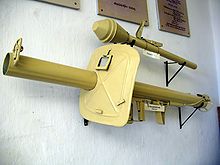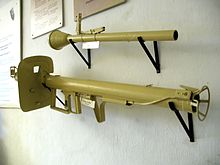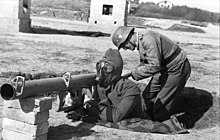Missile rifle 54
The Raketenpanzerbüchse 54 (short: RPzB 54 ), colloquially known as the Panzerschreck , was an anti-tank weapon that was used on the German side during the Second World War . It is considered an adapted in-house development of the American bazooka , was like this a reactive anti-tank rifle and also reloadable.
The Panzerschreck is sometimes mistakenly confused with the much better known Panzerfaust , which, however, as a recoilless gun, represents a completely different weapon from a technical point of view and, moreover, could only be used once.
development
At the beginning of the Second World War in 1939, the Wehrmacht only owned the anti- tank rifle 39 of the 7.92 × 94 mm caliber , which, however, showed poor performance against armored vehicles.
The Wehrmacht captured the first American bazookas on the Eastern Front , which had been made available to the Allied Soviet Union by the USA. That happened before the American-German confrontation in the Tunisian campaign . However, it is sometimes falsely reported that the Wehrmacht first captured the bazooka in Tunisia.
In Germany one recognized the potential of the still relatively unknown weapon, which until then had only been used to a very limited extent. Based on the bazooka, a separate construction has now been developed. The launch tube was generally enlarged in order to be able to fire a warhead of larger caliber . With the larger caliber, the penetration performance of the weapon was increased, which should be more reliable against the new Soviet tank models from 1943 and 1944. Development took more than a year before the weapon was delivered to the troops in the spring of 1944.
In the course of the " total war " proclaimed by Goebbels , parts of the Panzerschreck were assembled in the Herzogenaurach factories of the shoe manufacturers Adolf and Rudolf Dassler , who founded the Adidas and Puma companies after the war .
technology

In contrast to the Panzerfaust, the Panzerschreck was a pure rocket weapon in which the propellant was propelled during the flight instead of just at the start. In contrast to the bazooka, however, the propellant charge did not burn out for the safety of the shooter when leaving the launch tube, but further accelerated the rocket in free flight for the first two meters. The increased acceleration had become necessary due to the larger mass of the warhead, but did not increase its effective range. The increase in weight resulted from the expansion of the caliber from 60 mm to 88 mm. Compared to the American model, the Panzerschreck projectile weighed more than twice as much.
The warhead itself was based on the principle of the shaped charge . The explosion compacts a penetration body made of metal, which under the very high pressure is cold-formed into an arrow-like mandrel and, due to its extremely high speed and small attack surface, can penetrate even very thick armor.
The missile and warhead had the same caliber as the barrel. The explosive charge was ignited by an upstream impact fuse. After the launch of the rocket, the empty tube could be reloaded with a new rocket via the rear end and was therefore reusable in contrast to the launching device of the bazooka.
The bullet trajectory was stabilized during free flight by means of fins, which, in contrast to the American weapon, were much smaller in relation to the overall size.
Because of the hot exhaust jet from the rocket engine, the first versions required the shooter to wear a fireproof poncho and a gas mask to protect them from burns. This was made superfluous in later models by a protective shield mounted on the front end. The gun was nicknamed "Stovepipe" by the troops because of the smoke it produced when firing and its appearance.
commitment

The Panzerschreck was first handed over to the troops in the spring of 1944. By the end of the war, 314,895 rocket armored rifles and 2,218,400 projectiles had been produced. They were mainly used against tanks like the numerous Sherman or T-34s . But even against heavier vehicles, the penetration power of the Panzerschreck was still sufficient, so that even heavy types of tanks like the Soviet IS-2 could be fought effectively. The weapon was also used in infantry house-to-house fights, for example to break through house walls or barricades.
Compared to the Panzerfaust, the Panzerschreck had a similar penetration performance, but in contrast to most Panzerfaust models, it could also be used at greater distances and with much greater accuracy. The range was not large enough to be able to attack tanks offensively, so that according to the German tactical doctrine the Panzerschreck should only be used in close combat from a maximum of 115 m as an infantry defense against tanks.
While the ordinary Panzerfaust was in principle distributed to every soldier, Hitler Youth or Volkssturmmann, the Panzerschreck was developed as a weapon for trained soldiers. When deployed, two men were supposed to operate the rocket armored rifle, with one soldier wielding the weapon while the second loaded it with ammunition from behind.
A disadvantage turned out to be that after the shooting a clearly visible cloud of smoke developed, which often told the enemy the position of the squad. The hot and poisonous gases responsible for the development of smoke also escaped to the rear and made their use in buildings, shelters or bunkers impossible.
Further development
An aircraft-mounted version of the Panzerschreck was the 8.8 cm armored rifle barrel , which was redesigned for use as an external load under the wing station of a Focke-Wulf Fw 190 .
The Panzerschreck 54/100 mm was a custom-made product that had an even higher penetration power than the 88 mm version; but it was only produced in relatively small numbers because the production costs were higher.
Based on the Panzerschreck, the Belgian company Mecar SA developed the RL-83 Blindicide after the Second World War .
Technical specifications
| Parameters | Data |
|---|---|
| Manufacturer | Enzinger Union, HASAG , Jäckel |
| Unit price | 70 RM |
| caliber | 88 mm and 100 mm (special version) |
| total weight | 9.5 kg; 11 kg with protective shield |
| length | 1.64 m |
| Muzzle velocity | 130 m / s |
| Range | 100-200 m |
| Weight of the grenade | 2.4-3.3 kg |
| Penetration performance | 150-220 mm / 90 ° |
Museum reception
In the Military History Museum in Vienna is in the hall republic and dictatorship a Panzerschreck in the context of the Battle of Vienna issued. Various versions of the Panzerschreck and a section through a projectile are exhibited in the Defense Technical Study Collection in Koblenz .
literature
- Rudolf Lusar: The German weapons and secret weapons of the 2nd world war and their further development . JF Lehmann, 1956, ISBN 978-3-469-00296-9 , pp. 37 ff .
- Basil Timothy Fedoroff, Seymour M. Kaye: Encyclopedia of Explosives and Related Items . Ed .: Picatinny Arsenal. tape 8 , 1960, pp. 5 .
- Alexander Lüdeke : Weapons Technology in the Second World War . Parragon, Bath 2007, ISBN 978-1-4054-8584-5 .
Web links
swell
- ↑ Lida Mayo : The Ordnance Department: On Beachhead and Battlefront. United States Army Center of Military History, Washington DC, 1968, p. 31 [1]
- ^ Gordon L. Rottman : The Bazooka. Osprey Publishing , 2012, ISBN 978-1-84908-801-5 . P. 37
- ↑ mirror - Panzerschreck in the shoe empire
- ^ Manfried Rauchsteiner , Manfred Litscher (ed.): The Army History Museum in Vienna. Graz, Vienna 2000, p. 82.






